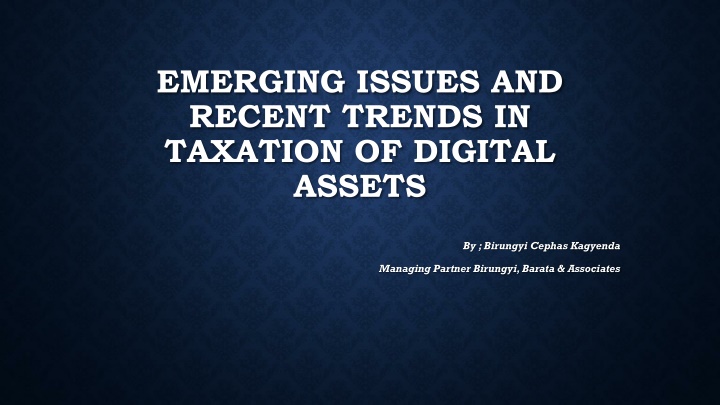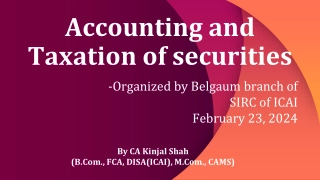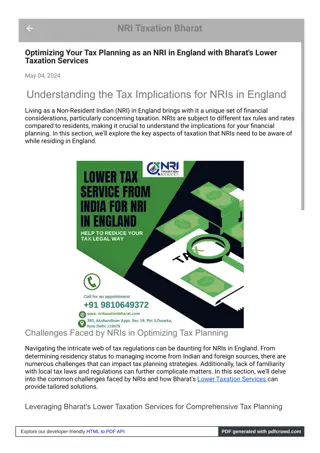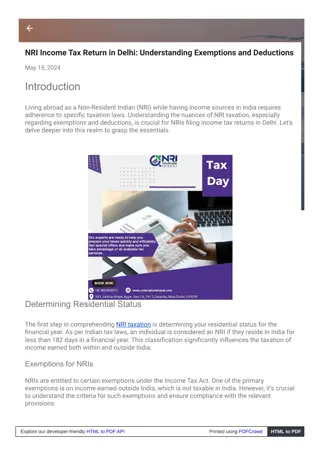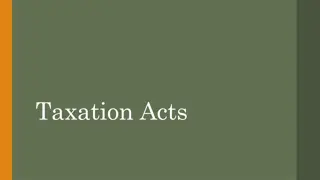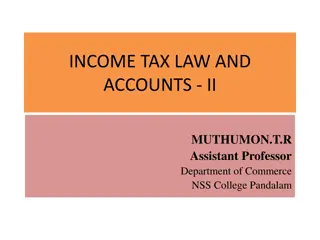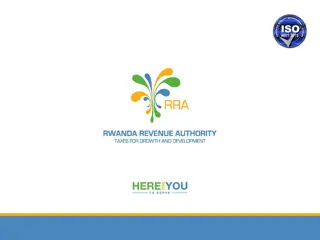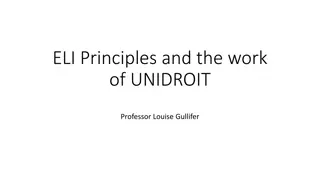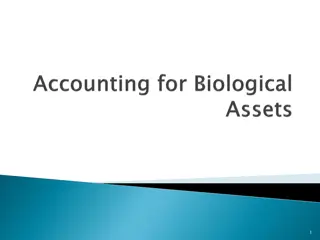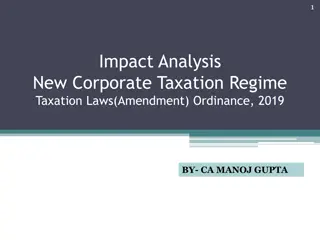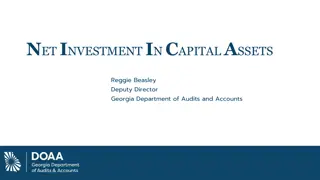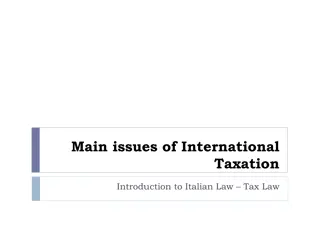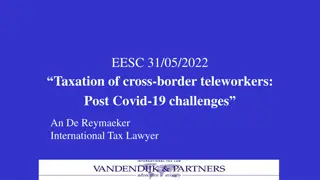Recent Trends in Taxation of Digital Assets
In this document, Birungyi Cephas Kagyenda explores the definition of digital assets, various digital business models, the legal framework in Uganda, and current trends in the digital asset landscape. The discussion includes issues related to international taxation and sourcing of digital assets, highlighting the shift from physical to digital services and the challenges that traditional tax laws face in this evolving digital economy.
Download Presentation

Please find below an Image/Link to download the presentation.
The content on the website is provided AS IS for your information and personal use only. It may not be sold, licensed, or shared on other websites without obtaining consent from the author.If you encounter any issues during the download, it is possible that the publisher has removed the file from their server.
You are allowed to download the files provided on this website for personal or commercial use, subject to the condition that they are used lawfully. All files are the property of their respective owners.
The content on the website is provided AS IS for your information and personal use only. It may not be sold, licensed, or shared on other websites without obtaining consent from the author.
E N D
Presentation Transcript
EMERGING ISSUES AND RECENT TRENDS IN TAXATION OF DIGITAL ASSETS By ; Birungyi Cephas Kagyenda Managing Partner Birungyi, Barata & Associates
DIGITAL ASSETS DEFINED Definition: An electronic record in which an individual has a right or interest. -Does not include an underlying asset or liability unless the asset or liability is itself an electronic record. -Held online. -Arise out of establishment of digital businesses. -Highly mobile and intangible ; physical presence of a company not necessary. -Exist in binary format and offer a right to use and this can range anywhere from motion pictures, documents and any other type of data. -The right to use is what makes data a digital asset. If there is no right to use then that data cannot be considered a digital asset.
DIGITAL BUSINESS MODELS Subscription model ; users pay a subscription fee to have access to a service or content on a website e.g.Netflix & Amazon. Advertisement model ; end users generate revenue by being exposed to advertising in platforms provided by companies likeYouTube andYahoo. Access model ; content and app developers pay to have access to end users data such as App Store. Peer to peer services ; provide users with ability to connect with people capable of providing a service such as accommodation e.g booking.com ,Airbnb. Online market places ;Amazon ,Alibaba,Jumia Uganda; Financial - Mobile money ,bitcoin Transport- Uber ,Safe boda Accommodation -Airbnb,Jumia travel, Online Market Jumia ,OLX
LEGAL FRAMEWORK ON DIGITAL ASSETS IN UGANDA No specific rules for taxation of the digital economy. General rules under the Income Tax Act & VAT Act Apply. The OECD Model Tax Convention on Income & Capital is applicable
THE CURRENT TREND IN DIGITAL ASSETS Movement from physical services to digital services. Increased use of Financial Technology (FinTech). Profit is created by charging usage or commission fees to service providers , users and advertisers. Tom Godwin; In 2015 Uber , the world s largest taxi Company owns no vehicles , face book the world s most popular media owner creates no content, Alibaba, the most valuable retailer has no inventory and Airbnb the world s largest accommodation provider owns no real estate .
ISSUES IN TAXATION OF DIGITAL ASSETS InternationalTaxation & Sourcing Existing tax law developed primarily in a market of physical goods and in person services and today, services are increasingly being provided digitally with minimal human intervention, through computer servers instead of physical distribution chains. The questions that this creates are; What is the Character of the income & how its taxed? ( royalty , rent or sale) Who earned the income and where was it earned/sourced? (Location affects how and where income is taxed under the source and PE principles. What is the machinery s role in source rules? Is the place of performance of a service the same as the server s location? Can the source of the service be partly in country X and part from the server s location? How should income be allocated between humans and machines in the supply chain Does it matter that a person in Country X programmed machines that are located in country Y? What impact do outsourced services have on place of performance?
ISSUES IN TAXATION OF DIGITAL ASSETS CONT. Transfer pricing Multi National Enterprises (MNEs) often have related entities whose engineers, programmers and artists convert traditional content into digital format. The revised and reformatted content is likely to be marketed, sold and distributed by other related entities that provide valuable services and marketing intangibles. Distribution channels for digital content may be very different from the channels used for physical goods, which may disrupt the established transfer pricing analyses. The Question as to who is doing what and for whom in a digital model may be different in the physical model. Technology (software & programs), Assets(servers & branded websites) New applications & technology create new value relationships and payment to the owners & developers. Marketing intangibles with different partners & approaches e.g hardware manufacturers or distribution channels. Require new TP analyses & documentation.
ISSUES IN TAXATION OF DIGITAL ASSETS CONT. Permanent Establishment Article 5 OECD Model Convention on Income and Capital - PE included ; place of management ;branch ;office ;factory ;workshop ;mine,oil or gas well ,a quarry or any other place of extraction of natural resources. Issue is whether the use in computer equipment , servers/tangible computer equipment in a country constitute a PE. OECD Commentary on Article 5 Paragraph 42; a server as distinct from mere websites could constitute a PE where the equipment is fixed and the supplier has the server at its own disposal. no PE would be created if the e-commerce activities carried on via the server are restricted to preparatory or auxiliary functions which are excluded under paragraph 4 of Article 5. It mentions some examples of activities which would generally be regarded as preparatory or auxiliary such as; - providing a communications link , like a telephone line between suppliers and customers - advertising of goods or services - relaying information through a mirror server for security and efficiency purposes - gathering market data for the enterprise - supplying information.
TAX CHALLENGES OECD/G20 BEPS Action 1 ; Addressing the Tax Challenges of the Digital Economy 2015 Final Report. Nexus. The continual increase in the potential of digital technologies and the reduced need in many cases for extensive physical presence in order to carry on business, combined with the increasing role of network effects generated by customer interactions,can raise questions as to whether the current rules to determine nexus with a jurisdiction for tax purposes are appropriate. Data. The growth in sophistication of information technologies has permitted companies in the digital economy to gather and use information across borders to an unprecedented degree.This raises the issues of how to attribute value created from the generation of data through digital products and services,and of how to characterise for tax purposes a person or entity s supply of data in a transaction, for example, as a free supply of a good,as a barter transaction,or some other way.
TAX CHALLENGES CONT. Characterisation. The development of new digital products or means of delivering services creates uncertainties in relation to the proper characterisation of payments made in the context of new business models, particularly in relation to cloud computing. VAT Collection. Where goods , services and intangibles are acquired by private consumers from suppliers abroad , there is an absence of an effective international framework to ensure VAT collection in the jurisdiction of consumption. For economic actors , and in particular small and medium enterprises (SMEs) , the absence of an international standard for charging , collecting and remitting the tax to a potentially large number of tax authorities ,creates difficulties and high compliance costs.
TAX CHALLENGES CONT.. Other Challenges (Administrative) Identification. While global business structures in the digital economy involve traditional identification challenges, these challenges are magnified in the digital economy. For example, the market jurisdiction may not require registration or other identification when overseas businesses sell remotely to customers in the jurisdiction, or may have issues in implementing registration requirements, as it is often difficult for tax authorities to know that activities are taking place , to identify remote sellers and to ensure compliance with domestic rules. Difficulties in identifying remote sellers may also make ultimate collection of tax difficult. Determining the Extent of Activities. Even if the identity of the role of the parties involved can be determined , it may be impossible to ascertain the extent of sales or other activities without information from the offshore seller, as there may be no sales or other accounting records held in the local jurisdiction or otherwise accessible by the local revenue authority. It may be possible to obtain this information from third parties such as the customers or payment intermediaries,but this may be dependent on privacy or financial regulation laws.
TAX CHALLENGES CONT. Identification of customers. There are in principle a number of ways in which a business can identify the country of residence of its client and/or the country in which consumption occurs. These could include freight forwarders or other customs documentation or tracking of Internet Protocol (IP) and card billing addresses. However, this could be burdensome for the business and would not work where customers are able to disguise their location. Loss of revenue , trade distortion and a challenge in managing tax liabilities generated by a high volume of low value transactions, which can create a significant administrative burden but marginal revenues.
OECD /G20 RECOMMENDATIONS Main concern by the OECD & G20 was the tax planning by MNEs that take advantage of the gaps in the interaction of different tax systems to artificially reduce taxable income or shift profits to low-tax jurisdictions in which little or no economic activity is performed. Traditional Principles of Tax Policy applicable; Neutrality , Efficiency ,Certainty & Simplicity, Effectiveness & fairness , Flexibility. Modify the list of exceptions to the definition of PE to ensure that each of the exceptions included therein is restricted to activities that are otherwise of a preparatory or auxiliary character, and to introduce a new anti-fragmentation rule to ensure that it is not possible to benefit from these exceptions through the fragmentation of business activities among closely related enterprises. Modify the definition of PE to address circumstances in which artificial arrangements relating to the sales of goods or services of one company in a multinational group effectively result in the conclusion of contracts, such that the sales should be treated as if they had been made by that company.
OECD/G20 RECOMMENDATIONS Provide specific guidance to ensure that the transfer pricing analysis is not weakened by information asymmetries between the tax administration and the taxpayer in relation to hard- to-value intangibles, or by using special contractual relationships, such as a cost contribution arrangement. Design Controlled Foreign Company (CFC) rules that would subject income that is typically earned in the digital economy to taxation in the jurisdiction of the ultimate parent company.
TAXATION OF IMPORTED SERVICES - UGANDA Section 4 VAT Act; Tax is charged on;- a) Every taxable supply made by a taxable person; b) Every import of goods other than an exempt import; and c) The supply of imported services, other than an exempt service, by any person. Section 5(c)VAT Act; In the case of a supply of imported services, tax is to be paid by the person receiving the supply. Regulation 13(1)VAT Regulations; A person who receives imported services other than an exempt service shall account for the tax due on the supply, and the taxpayer shall account for that service when performance of the service is completed, or when payment for the service is made, or when the invoice is received from the foreign supplier whichever is the earliest.
TAXATION OF IMPORTED SERVICES CONT.. Section 28(1)VAT Act ; a credit is allowed to the taxable person for the tax payable in respect of - all taxable supplies made to that person during the tax period; or all imports of goods and made by that person during the tax period. In case of a digital supplier of a service who does not issue invoices to the taxpayer , the taxpayer cannot claim input tax without a tax invoice. When the taxpayer accounts for the VAT paid during the transaction, he/she also becomes a supplier of the imported services. The taxpayer then issues a tax invoice to himself and can then claim the input tax using the tax invoice raised.
WHICH WAY FOR UGANDA? If a supply of a service is made in Uganda from an unknown country, who is liable to pay tax? How is the transaction monitored? How are commissions charged by Service providers accounted for? What assets are being provided, how will they be captured? When a service provider makes a Mark-up how is it identified? If government is to regulate how will e-payments for services be monitored?
